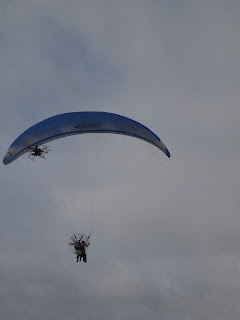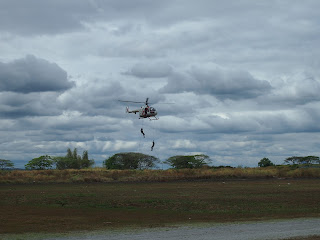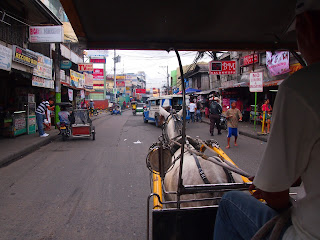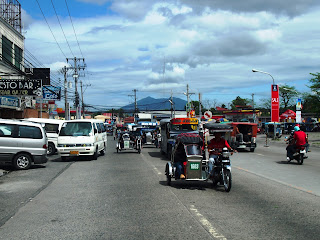Of all the weekend getaways I’ve enjoyed in Southeast Asia
over the past three and a half years, perhaps the most unexpectedly,
surprisngly awesome was this past weekend’s trip to Clark in the Philippines. I
just got back yesterday, and up until a few days before my Friday afternoon
flight, I hadn’t even made up my mind about going. You see, I booked my flights back in early January because I found stupidly cheap tickets and figured that even
if I wound up cancelling, it couldn’t hurt to book. At one point,
Kevin, our friend Matt, Courtney and Sonia all toyed with the idea of joining
me for the trip, but for one reason or another, none of them wound up booking
tickets. I wasn’t sure whether it was worth it to go alone, but in the end I
decided to take a chance. I’m so glad I did, because the memories of the weekend
will surely rank among the most unforgettable I’ve yet experienced out here. It was a gamble, but it also proved that some gambles really do pay off.
Clark is best known as an alternative airport for those looking to save a bit of money. It is only about a two hour drive from Manila, and as such, several budget airlines offer
very cheap airfares. Many passengers immediately make a beeline to the
Philippines’ capital city as soon as they clear immigration since nearby Angeles City is notoriously known as one of the region’s seediest locales, not necessarily
an ideal spot for a family holiday.
However, once a year, Clark is host to an extraordinary
festival called the Philippines Hot Air Balloon Fiesta. That’s a bit of a
misnomer really, because as it’s tagline accurately suggests, the weekend-long
event is a celebration of "everything that flies.” From bubbles and kites to
jumbo jets, it’s hard to think of a flying object that did not play a part in
the weekend’s festivities.
The Fiesta first appeared on my travel radar two or three
years ago, when I read about it on some website or other. It’s always been on
my mind when booking flights, and in the past I’d tried to get a group together
to attend the event, but for some reason, it never came together. This year,
though, I made up my mind to finally attend, and the wait was well worth it!
I flew Cebu Pacific from Singapore to Clark on Friday afternoon,
arriving around 8pm. I waited until a day or so before the flight to finally
book a hotel, and my options were pretty limited. I finally settled on Tune
Hotel, run by AirAsia, the region’s budget airline. It had decent reviews and
looked very close to the fiesta’s location, and in the end, it turned out to be
a good choice. The guy sitting next to me on the plane, another American expat
living in Singapore, told me the hotel’s philosophy was to provide very nice beds and power showers but little else, managing to keep price down but comfort
and cleanliness high. So yes, my room was tiny, but the bed was
uber-comfortable and the shower was great. The staff was helpful and friendly
to boot, which can always lift a hotel stay up a few notches.
After getting settled in my room, I went down to the desk to
enquire about the following day’s festival. The lady on duty suggested I head
to the field around 5am in order to be there for the morning’s activities, so I
booked a cab, headed up to my room and had an early night. I was still extremely unsure about how this whole weekend was going to turn out, and as I set my alarm for 4:45am, I thought that the whole thing might have been a bad idea.
Dark and early the next morning I was in a car headed
towards Omni Aviation, venue of the 18th Annual Philippines Hot Air
Balloon Fiesta. It was still pitch black outside when I bought my ticket at the entrance gate, but
there was a steady crowd of people flowing into the massive festival grounds.
In the darkness, I could discern some small airplanes scattered about, and also
a few glowing objects floating in the night sky. A man’s voice was explaining
various aspects of ballooning. And it was the first time I finally felt sure that I had made
the right decision to take this trip.
Omni Aviation is set on a flat plain strikingly straddled by
two volcanoes: the extinct, photogenic Mount Arayat to the east and the active Mount
Pinatubo of the Cabusilan Mountain Range to the west. Slowly, about twenty minutes
after I had entered the field, the sun began to illuminate the skies behind
Arayat, and the black night first turned a deep ruby red and then into an
unforgettable mix of pink and golden orange. (It’s beginning to seem like no trip to the
Philippines is complete for me without experiencing a sunrise. First in
Boracay, then in Panglao, now in Clark, watching the beautiful morning come
into full force has become an indelible part of each of my trips.)
As the sky got brighter and brighter, the first of the
balloons became visible on the field. The commentator was discussing the
clouds, hoping they weren’t rain clouds but cautiously saying it was too early
to tell. Hopefully, he said, the sun would dispel them and we would have clear,
perfect skies for the morning flight. And that’s exactly what happened.
More and more balloons appeared on the field, the first of which
were slowly being inflated. I bought a “photographer’s pass” for access to the
field, something I had read about online during my research leading
up to the trip. It wound up being the best thing I could have done. It only
cost 1000PHP (US$25) but it allowed me to wander around from one balloon to the
next as I pleased, while most of the crowd had to stand behind a fence to watch
the action from afar.
Before I knew it, the entire field was covered in balloons
of every color, size and shape—a bouquet of tulips, a space shuttle, a smiling
sun, a fire truck, a pink elephant, even an upside-down humpty dumpty! I’d never
seen such cleverly-shaped hot air balloons in person, and watching them slowly
take shape as the sun continued to light the dawn sky was as unforgettable a
morning as I’ve ever had.
Then, like magic, the first of the balloons lifted into the
air and floated away. Soon others followed it, until balloons were taking off
all around me and disappearing into the distance. And still more balloons were
taking shape all over the field. In the end, there were about thirty balloons
that took part in the dawn flight that morning.
Hot air balloons work on the well-known law of physics that
hot air rises. Fans are used to channel air into the balloons before this air
is heated, causing the balloons to rise. However, the air inside the balloon
must be hotter than the outside air in order for this principle to work, and
that’s why flights have to take place when the temperature is coolest, usually
around sunrise and sunset.
As the balloons were taking off, paragliders were flying
around the field. These paragliders were unlike anything I had ever seen. They
had motors on their backs propelling them all over the place, and a parachute aiding
them in their flight. It was amazing to watch them buzz around, about as close
to flying as I can imagine.
One balloon, nicknamed Sunny Boy, stayed back to provide the crowd with an endless photo op. A sun-shaped balloon sporting cool shades with signs over the eyes proclaiming, "It's more fun in the Philippines," Sunny Boy certainly knew what he was talking about, and I couldn't have agreed with him more. After all the balloons had either taken off or—in the case
of a few—been deflated and packed up again, the rest of the day started. I
had looked at the schedule online and known that hot air ballooning was only a
part of this festival, but it didn’t quite hit me until now that the whole day
would turn out to be an informative, wildly entertaining celebration of mankind’s
fascination with flight.
After the last of the paragliders came down, Dr. Meynard
Halili took to the skies in a tiny prop plane, delighting the crowd with loops
and spins and inverted flying. His friend, our commentator, explained each and every
move, from the Cuban Eight to the Hammerhead to the Clover Leaf. And he also
said that Dr. Meynard learned to fly at the age of 40, proving that it’s never
too late to follow your dream.
After he landed his plane, some remote controlled jets took
to the skies, miniature versions of some of the most powerful flying machines
known to man. With powerful, miniature engines, these models could perform
incredible stunts of airborne wonder, and it was really cool to see them show
off.
Still, nothing was as breathtaking as what followed: the
Breitling Jet Team’s Aerobatic Exhibition. Seven pilots from France performed daredevil maneuvers in stunning formations, zipping by and wowing everybody who
could see them. Set to music and complete with narration explaining their stunts,
the exhibition was awe-inspiring.
This was the team’s first stop on an Asian tour that will
take them to several other spots before heading back to Europe. And watching
their highly-demanding, precise aerial feats lets me know the rest of their
tour will be a hit. I could have watched them all day, and as one of their
stops on the tour is in Singapore, perhaps I will get another chance to see
these daredevils in action.
Having not eaten yet, I decided to leave the field and head
into the crowded festival grounds to have some breakfast after the Breitling
Jet Team had finished. I also realized that as great a vantage point for catching
the action as the field had been, the real atmosphere of the event was here in
the heart of the crowd. Music blared, stalls sold all kinds of food and drinks,
hundreds of people were flying their kites, and there were tons of impromptu
shops that had sprung up selling all manner of souvenirs. It was a good old-fashioned
carnival, the perfect place to enjoy what was turning out to be quite a beautiful
sunny day.
Some ulta-light aircraft flew by, and then skydivers jumped
out of their planes 9,000 feet above us and landed in the middle of the field.
At one point, a gaggle of bicycles even rode by before some experienced racecar
drivers demonstrated “car drifting,” though I didn’t quite understand their
inclusion in a festival celebrating “everything that flies.”
Next up was one of the day’s most surprisingly entertaining
features—the balloon bursting competition. Four or five planes took turns
flying over the field trying to pop yellow balloons set free as they flew by.
(Planes with propellers on their wings had a much harder time completing the
task than planes with propellers on their noses.) As each pilot either accomplished
or botched the task, the crowd cheered wildly or moaned disappointedly. I
couldn’t believe how engrossing the simple event turned out to be, but I was
almost embarrassingly engaged in the action!
The Philippine Coast Guard even put on a very cool exhibition
demonstrating just how they go about saving people at sea, using one of their
planes and a helicopter to aid in the reenactment of a maritime rescue mission.
My favorite plane of the weekend had to be a bright yellow 1942 PT 13 Stearman, beautifully restored with all original parts. It was clear from
the second it taxied by on the runway, complete with an appropriately
era-attired pilot, that this was a well-loved airplane. Watching it take to the
skies, you’d never know it was over seventy years old! It looped around, flying
sideways and rolling in the air, like something out of an old war movie. The
bi-plane stole the show for me, and I’d love to fly in one like it someday, if
I ever get the chance.
The afternoon was chock-full of demonstrations. First, a
German pilot flew an engineless wood-and-fabric glider thousands of feet in the
air for about twenty minutes. Next, an incredible kite-flying exhibition blew
my mind, with multiple kites performing synchronized routines set to music! It
was literally like watching kites do the samba or cha-cha! Alongside them, horse-shaped and
fish-shaped kites danced in the breeze. Who ever knew you could get so
inventive with kites!?!
At one point, a pilot demonstrated just how those aerial banner
advertisements get to their position trailing behind a plane. It’s something I realized
I had never even thought of before. I just assumed a plane could take off with
the banner hanging off its tail, but in actuality, this would make takeoff
impossible. Instead, the pilot takes off normally, loops around and flies back
over the runway with a hook hanging down from the tail of the plane and a
string attached to the banner suspended between two poles. The pilot must maneuver
his plane so that he can catch the string with his hook, and then the banner
floats in the wind behind the plane, visible to all on the ground. It might sound confusing when put into words,
but the quick demonstration that afternoon made it perfectly clear.
Later in the afternoon, there was a really fun “flour-bombing”
exhibition, where pilots in ultra light aircrafts attempted to drop bags full
of flour on their “targets” below, who just happened to be the manager and president
of a local flying club! The bags burst upon impact, sending a cloud of dust
into the air, but they never managed to directly hit their targets!
I could hardly believe it, but after the flour bombing
ended, the sun was starting to set over the Cabusilan Mountains! I had been in
the sun with hardly a minute’s cover since it rose that morning! And the day had
just dissipated what with all the fascinating aerial stunts on display over the many hours that followed.
As the skies grew darker, the iconic hot air balloons made
their return for “night glow,” the dusk-time display where the balloons inflate
but stay attached to the ground, showing off their golden aura to the crowd.
Donning my “photographer’s pass” vest, I re-entered the field to see the
balloons up close. Although all thirty balloons were supposed to come back for the
display, for some unexplained reason only four or five actually inflated and
glowed for the crowd. But an amazing musical showcase took place on the nearby
stage, and even the sight of the few balloons proudly glowing in the dark sky was
a sight to remember. I could only imagine what it would have been like if all
thirty had been there!
It was nearly 8:30pm when I left the festival grounds that night,
fifteen hours after I had arrived that morning. Again, the skies were pitch
black.
I walked a ways back toward the Tune Hotel, but ultimately
hopped in a local trike to take me on the final stretch, so exhausted was I
from the full day I had just enjoyed. It was all I could have hoped for and then
some, and I loved every minute of it. I was so glad I had gone through with my plans to attend! And as I’m sure you can imagine, I had no
trouble falling asleep almost as soon as my head hit the pillow.
Although I toyed with the idea of waking up even earlier
Sunday so that I stood a chance of actually riding in one of the balloons, I
ultimately opted to sleep a little later and spend my day exploring the nearby
town of Angeles. Before leaving, I looked out my window and realized I had a view of Omni Aviation. I saw a couple of hot air balloons lingering on the field and stuck around to watch the Breitling Jet Team perform again from the comfort of my room!
I left the hotel and jumped in a trike to go to the Holy Rosary Church in time for 10am mass. The church was beautiful, designed and built in a distinctly Filipino style, with imposing stone bell towers and golden chandeliers inside. Near the entrance there was a memorial to six American soldiers who were killed when their plane crashed through the roof of the church after being struck by a Japanese anti-aircraft gun in January 1945.
I left the hotel and jumped in a trike to go to the Holy Rosary Church in time for 10am mass. The church was beautiful, designed and built in a distinctly Filipino style, with imposing stone bell towers and golden chandeliers inside. Near the entrance there was a memorial to six American soldiers who were killed when their plane crashed through the roof of the church after being struck by a Japanese anti-aircraft gun in January 1945.
The area around Holy Rosary was fascinating, full of
character and buzzing with life. Trikes, jeepneys, horse-drawn carriages… the
mansion where General Arthur MacArthur (father of WWII General Douglas MacArthur) had lived when he was based in Angeles City at the turn of the twentieth century…
People had told me there was nothing to see or do in Angeles, but I’m so
glad I decided not to listen to them and find out for myself. Like Cebu
City, I can’t call it beautiful, but it was atmospheric and charming in a decidedly
Filipino way, and I loved it.
I even took a forty minute horse-drawn carriage tour around
town, sharing traffic-clogged main streets with all manner of vehicles only to
turn down quiet dirt lanes lined with homes and churches and little shops.
Every street was teeming with life, and the people were so friendly, waving to
me and saying hello, some even posing for pictures. I’ve said it before and I’ll
say it again, the Filipinos are what truly make their country the magical place
that it is.
That ride was such a cool way to get to explore parts of the city I probably never would have discovered had I just wandered around on my own. My driver even rode me past his house, waving and chatting with his neighbors as we drove by. Kids were playing on the street, families were out doing chores and others were just relaxing in the nice weather.
After my tour was over, I hopped on a jeepney and made my way to the local shopping mall. Jeepneys are perhaps the Philippines’ single most iconic mode of transport. The historic roots of the vehicle stem, as you can probably guess, from World War II. When the war ended and the Americans departed, many jeeps were left behind. The locals expanded the bodies of the vehicles so they could seat many more passengers and the jeepney was born. In the years since, it has become an indelible feature of the country. For 8PHP (US$0.20) you can ride pretty much anywhere you want along the route, simply flagging one down as it passes and letting the driver now when you want to jump out. They can get crowded and hot, but they are such a fun way to get around!
After my tour was over, I hopped on a jeepney and made my way to the local shopping mall. Jeepneys are perhaps the Philippines’ single most iconic mode of transport. The historic roots of the vehicle stem, as you can probably guess, from World War II. When the war ended and the Americans departed, many jeeps were left behind. The locals expanded the bodies of the vehicles so they could seat many more passengers and the jeepney was born. In the years since, it has become an indelible feature of the country. For 8PHP (US$0.20) you can ride pretty much anywhere you want along the route, simply flagging one down as it passes and letting the driver now when you want to jump out. They can get crowded and hot, but they are such a fun way to get around!
At the local mall, called SM Clark, I caught a screening of
A Good Day to Die Hard. Truth be told I had spent far too much time in the sun
the day before, and I knew I should do my best to stay out of it if possible. A
2:30pm movie seemed like a good way to protect my skin for a few hours, and I opted for the IMAX cinema, watching the movie on one of the biggest screens I’ve
ever seen!
After a quick pit stop at the hotel to freshen up a bit
after another relatively long day, I headed back to the fiesta for my last
night. It was cheap enough to get in, and I wanted to take some more time to
bask in the festive atmosphere, sample the food stalls and shop at the souvenir
booths. Plus, I figured it would be
worth it just in case tonight’s night glow featured more of the balloons. It turned
out to be a great decision.
Almost all of the balloons showed up that night, and there was even a fireworks display capping off the
illuminations. Enjoying a few San Miguels was a perfect compliment to the
colorful display before me, and I had some great Mexican tacos for dinner from
one of the many food stalls, run by a delightful brother-sister duo named
Eduard and Brenda. They were very friendly, even offering me a free shot of
tequila while explaining how she makes their out-of-this-world delicious Habanero sauce while he does
the rest of the cooking.
I walked back to the Tune again, and laid down on my comfortable
bed, content to spend my last night of the weekend watching television. You
see, we cancelled our television subscription in Hong Kong before I moved to
Singapore, and down here Sonia doesn’t have television channels set up either,
so it’s been a long while since I’ve been able to simply lie back, relax and
channel surf. I guess it sounds weird, but it was a perfect last night for my
little weekend getaway.
My flight on Monday
wasn’t until 12:10pm, so I checked out of the Tune and asked the lady at the
desk if she could recommend a place for breakfast nearby. She suggested the
Savannah Resort just a few doors away, and I sat by their pool, had a Bloody
Mary and some breakfast, and chilled out for a good two hours before heading
back to Diosado Macapagal International Airport for my flight back to
Singapore.
.JPG)









































No comments:
Post a Comment